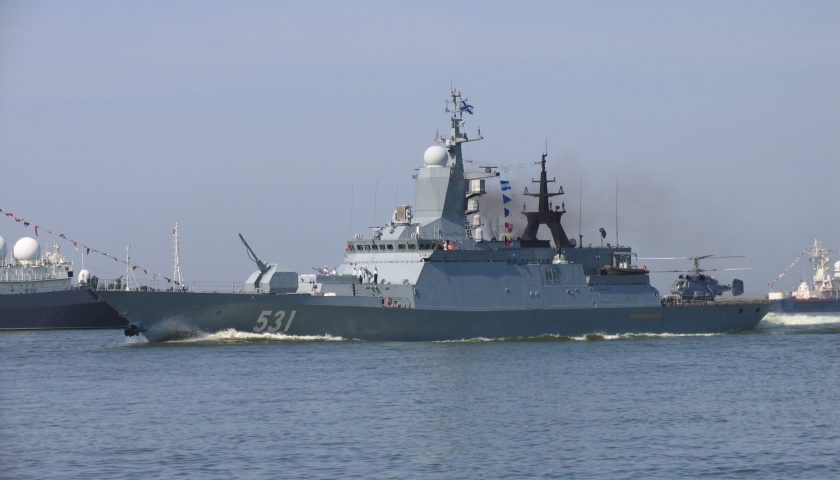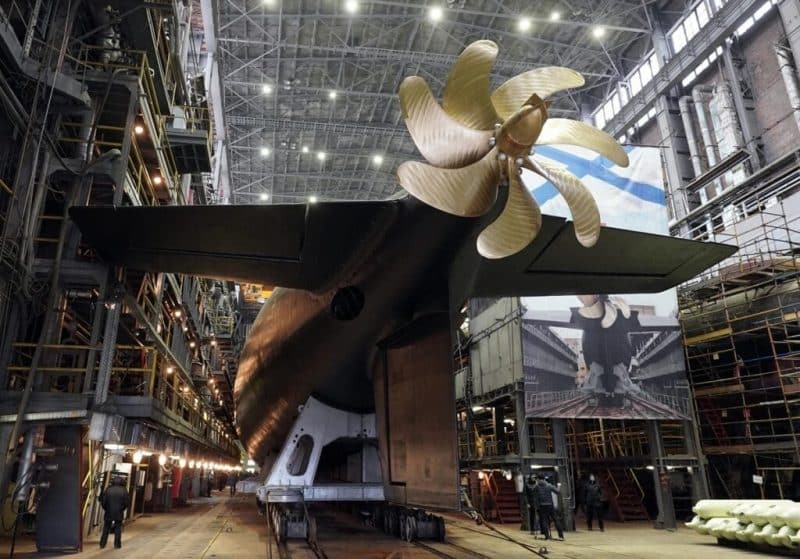The 16 July 2020, Moscow had created the event by simultaneously launching in its shipyards the construction of 2 project 23900 assault helicopter carriers of more than 25.000 tonnes each, 2 new frigates of project 22350 Admiral Gorshkov, as well as two nuclear attack submarines of the 885-M Iassen project. Obviously, the Russian authorities appreciated the renewed notoriety generated by this event in the field of military shipbuilding as in the international and national media, since on the occasion of the celebrations around Victory Day and its spectacular annual military parade in Red Square on May 9, she will repeat the exercise, laying the keel of 6 new warships, without the exact date having yet been formalized.
Thus, the Russian shipyards will begin, on the same day, the simultaneous construction of two new conventionally powered attack submarines Project 636.3, designated by NATO as Improved Kilo, bound for the Black Sea fleet, where they will join the 4 other Improved Kilos previously delivered. In parallel, two new corvettes of the Project 20380 Steregushchiy project will see their keel laid in the Amur shipyards in Komsomolsk-on-Amur, to join the Pacific fleet. Finally, and above all, the last two of the 10 nuclear submarines launching devices of the 995A Boreï-A project will see their construction started by the North Shipyards of Severodvinsk.

The simultaneous start of work for these 6 ships represents the only real new information, since their construction was announced a long time ago, but it shows Moscow's new naval ambitions, which intends not to leave to Washington and Beijing the possibility of appropriating alone the primacy over the oceans. Indeed, taking into account these next 6 programs, Russian shipyards are currently building or testing no less than 6 new Borei-A SSBNs, 6 Iassen-class SSNs, 5 attack submarines with conventional propulsion, including 3 Improved Kilo and 2 Lada, 2 assault helicopter carriers 23900, 6 Admiral Gorshkov frigates, and 13 corvettes including 5 Steregushchiy, 3 Gremyashchiy, 2 Merkuryi and 3 Buyan-M to speak only of the main combat units. All of these units are due to enter service by 2027.
The submarines 636.3 Improved Kilo measure 4000 tons when diving for a length of 73,5 meters, and a diameter of almost 10 meters. Devoid of anaerobic system, they can only navigate 400 nautical miles in submersion at a speed reduced by 3 knots, but they can reach a speed of 20 knots in diving and 17 knots in the snorkel, and their autonomy exceeds 7.500 nautical miles in this mode. Their crew of 53 men can hold the sea for 45 days, and deploy a large array of armaments, including 18 heavy torpedoes as well as 4 Kalibr cruise missiles or as many medium-change anti-ship missiles, as well as 24 mines. anti-ships. They could also use Strela mid-range short-range anti-aircraft missiles for self-defense against drones, ASM helicopters and maritime patrol planes. Known to be very discreet at low speed, the Improved Kilo are formidable adversaries if they manage to cut off a naval force. 6 Units are already in service in the Russian Pacific fleet, 6 other units, including the two ships which will see their keel laid next month, are intended for the Black Sea fleet. Moscow has also announced that it intends to order a new batch of 6 buildings for its Baltic Sea fleet.

The corvettes of the project 20380/20381 Steregushchyi are versatile combat ships of 2200 tons and 105 meters in length characterized by a significant firepower, but by a limited endurance at sea of only 15 days, specializing them in fact in defense. coastal or in the control of closed or semi-open seas, such as the Baltic or the Black Sea. However, 6 of the 12 Steregushchyi already delivered or under construction are intended for the Pacific fleet. They use an impressive arsenal for a ship of this tonnage, with a 190mm A-100 gun, 2 × 4 Kh-35 anti-ship missiles with a range of 300 km, 12 vertical silos for the Redut medium-range anti-aircraft system derived from the land S-350, two 2mm AK-30M anti-aircraft and anti-Gatling missile defense guns, as well as two 630mm quadruple Paket torpedo launchers. In addition, they have a powerful 2D Furke-324 radar with a range of 3 km, and a sonar suite consisting of hull sonar and towed sonar. A Ka-27 helicopter anti-submarine warfare and an Orlan-10 reconnaissance drone complete this set.
The SSBN of the Boreï class are expected to become the backbone of the submarine component of Russian strategic deterrence. 170 m long with a submerged tonnage of 24.000 tonnes, they are the largest submersibles in the world, with the exception of the last representative of the class. Typhoon still in service, the TK-208 Dmitry Donskoy, which will remain in service until 2026. After the first 3 Borei admitted to service between 2012 and 2014, the Russian Admiralty headed for an improved version, designated Borei-A, which corrected certain defects of the initial Borei, including optimized hydrodynamics, the use of a pump-jet type ducted propeller, improved detection and communication systems, and reinforced acoustic stealth. Thanks to its 650 MW OK-190V nuclear reactor, the ship can reach 33 knots while diving, and 15 knots on the surface. In addition to the 6 torpedo tubes for self-defense, the Borei each use 16 RSM-56 Bulava intercontinental ballistic missiles weighing 37 tons, each armed with 6 to 10 MIRV nuclear warheads of 150 kt, for a range estimated between 8500 and 9000 km. If 3 Boreï and 1 Boreï-A are in service today, 4 other Boreï-A are under construction, bringing the total number of submarines to 10 SSBNs by 2027 (taking into account the 2 units whose construction will begin in May) to replace the Delta and the Typhoon still in service with the Russian strategic submarine forces. Beyond that, Moscow has announced its intention to increase its fleet to 12 SSBNs, with a new order for 2 Borei-A under the next GPV (Russian Military Programming Law).

Despite its limited resources, and a defense budget barely exceeding $ 65 billion, Russia is therefore making a very significant effort to modernize and sometimes rebuild its war fleet and its submarine deterrent component. While in 2008, Moscow was no longer able to ensure the permanence at sea of its SSBNs, and struggled to dispatch even a few ships simultaneously during major crises (Georgia), the country now has an arsenal powerful and extensive naval, equipped with both modern and very well armed equipment, bringing the Russian fleet back among the most powerful on the planet, without however hoping to equal the American or Chinese fleets with much greater means, except in the nuclear field. Anyway, Moscow now starts every year the construction of ten major naval units each year, that is to say between 4 and 5 times more than does it France, Germany, or Great Britain, however all three having a national wealth between 30 and 80% more important than that of Russia. At this rate, Moscow will also have gained the naval military advantage over Europe in the next few years, as has already been the case strategically, on land and in the air in recent years.

